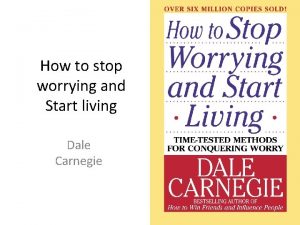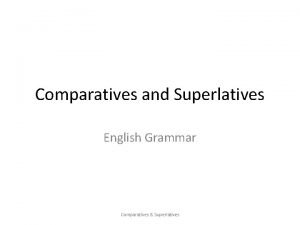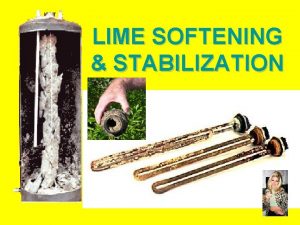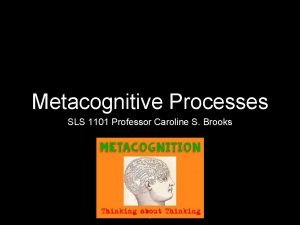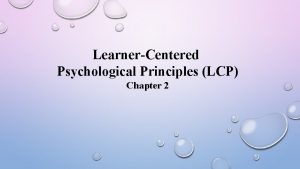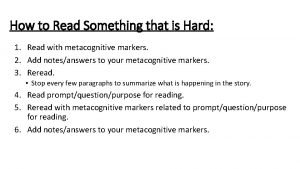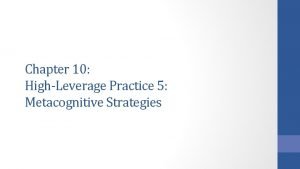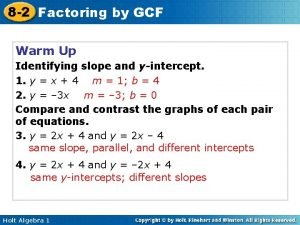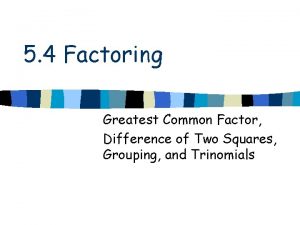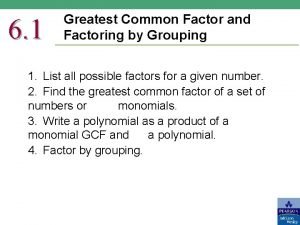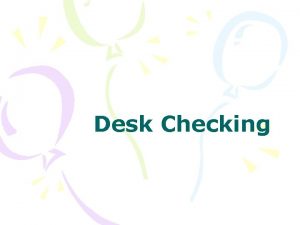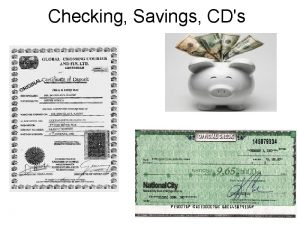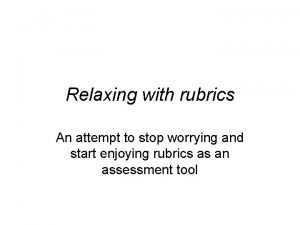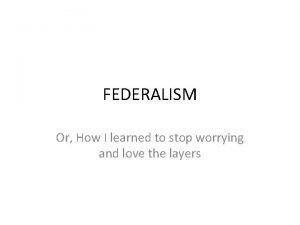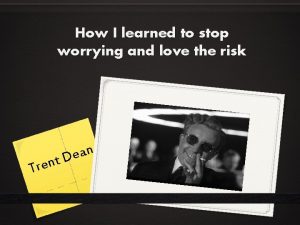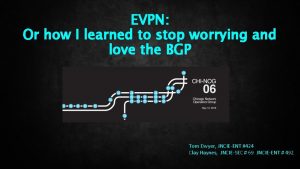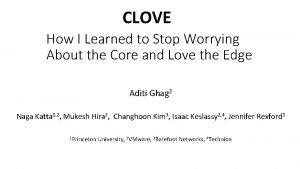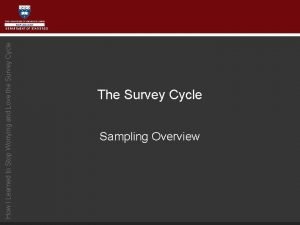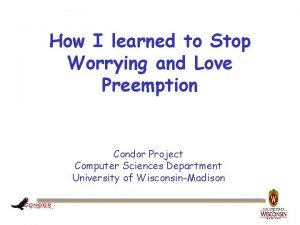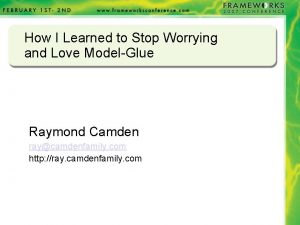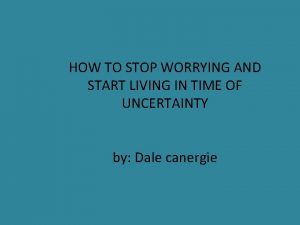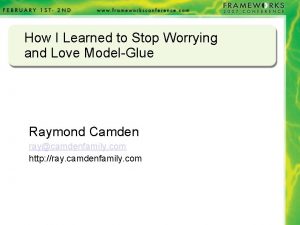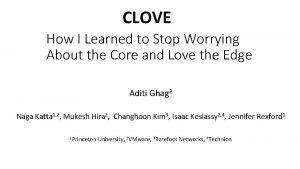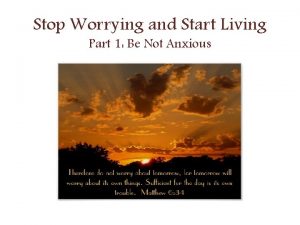Stop Rules for Worrying Checking A Metacognitive Factor























- Slides: 23

Stop Rules for Worrying & Checking: A Metacognitive Factor in Perseverative Psychopathologies Graham Davey University of Sussex, UK

Collaborators Benie Mac. Donald Helen Startup Gary Britton Suzanne Dash Frances Meeten Fergal Jones

Introduction § Perseveration is a defining element of many psychopathologies § Examples include worrying (GAD), checking (OCD), rumination (in major depression) § Perseverative activities are usually ‘neutralizing’ activities § Linked to meta-cognitive and global beliefs about how to deal with distressing emotions

What are ‘stop rules’? • • Relate to Task Motivation Performance Focused OR Task Focused ‘Enough’ OR ‘Enjoy’ ‘As Many as Can’ (AMA) OR ‘Feel Like Continuing’ (FL)

What do we know about stop rules? § Often not easily verbalizable § Can often be derived from dispositional characteristics or meta-beliefs about emotional control strategies § Stop rule type is linked to mood § Stop rules interact with mood to determine perseveration at a task (the ‘Mood-as-Input Hypothesis’, Davey, 2006, Startup & Davey, 2001).

Stop Rule x Mood Interaction Effects § Hawksley & Davey (2010) § Depressive Rumination Task § Participants asked to iterate what had made them feel depressed during a recent episode of depression § Both mood (positive v negative) and stop rule (AMA v FL) were manipulated

Hawksley & Davey (2010)

Perseverative Worrying • • Manipulating Stop Rule (Startup & Davey, 2001) Stop Rules & Responsibility (Startup & Davey, 2003) Stop Rule deployment in High & Low Worriers (Davey et al. , 2005) Do stop rules change during a worry bout? (Davey et al. , 2007)

The Catastrophizing Interview 1. 2. 3. 4. 5. 6. 7. 8. 9. 10. 11. 12. 13. 14. 15. 16. 17. 18. 19. 20. 21. 22. 23. I’m worried about not being able to move That I would be attacked in some way That I would not be able to fight back That I would not be able to control what other people did to me That I would feel inadequate That other people would begin to think I was inadequate That in my relationship with those people I would not be respected That I would not have any influence over others That other people would not listen to me That it would cause a loss of self-esteem That this loss of self-esteem would have a negative effect on my relationships with others That I would lose friends That I would be alone That I would have no-one to talk to Because it would mean that I would not be able to share any thoughts/problems with other people That I would not get advice from others That none of my problems would be adequately sorted out That they would remain and get worse That eventually I would not be able to cope with them That eventually my problems would have more control over me than I had over them That they would prevent me from doing other things That I would be unable to meet new people and make friends That I would be lonely

Manipulating Stop Rules in High & Low Worriers

Characteristics leading to the deployment of AMA stop rules

Worry Stop Rule Check List AMA – ‘Enough’ § I must find a solution to this problem, so keep thinking about it. § I must try and think about the worst possible outcome, just in case it happens § I must think everything through properly FL – ‘Enjoy’ § What’s done is done, so what’s the point in worrying? § I don’t have time to think about this now § Stop worrying, things always work out for the best.

Davey, Startup, Mac. Donald, Jenkins & Patterson (2005) QUESTIONNAIRE VARIABLE AMA FL PSWQ Trait Worry . 54*** -. 15 PFQ Shame . 39*** -. 08 PFQ Guilt . 27** . 08 COWS Negative Cons . 35*** -. 08 COWS Positive Cons . 49*** -. 10 CAT INTERVIEW Steps . 43* . 04

What ends a worry bout? - Mood changes during worrying 14 12 10 8 6 Low Worrier 4 High Worrier 2 0 -2 -4 AMA FL No Stop Rule

Changes in Stop Rule Endorsement 140 120 100 80 Prior to Task 60 End of Task 40 20 0 AMA FL

Perseverative Checking • • Compulsive checkers deploy AMA stop rules (Meyer, Fisher & Wells, 2009) Termination of rituals often based on subjective stop criteria Explanatory constructs such as ‘Inflated Responsibility’ interact with mood (Mac. Donald & Davey, 2005) It is the goal-directed nature of checking that causes perseveration, not its complexity

Mac. Donald & Davey (2005) Black = High Responsibility White = Low Responsibility

Stop Rule is not Independent of Mood • • Negative mood facilitates endorsement of AMA checking stop rules (Gary Britton) Negative mood facilitates endorsement of AMA worry stop rules (Suzanne Dash)

Britton & Davey (2011) Mood & Checking Stop Rules 70 60 50 40 Negative Mood 30 Positive Mood 20 10 0 AMA FL

Dash & Davey (2011) Mood & Worrying Stop Rules 50 40 30 20 10 0 AMA Negative Mood Neutral Mood Cognitive Priming

Dash & Davey (2011) Systematic Processing & AMA deployment mediate effect of Negative Mood on Worry Scores

Summary § AMA Stop Rules + Negative Mood = Perseveration § Perseveration is not a Dispositional Style § Perseveration is a Performance Factor caused by a configuration of stop rule and mood § Deployment of AMA stop rules is facilitated by Negative Mood

Future Directions § More Research on Stop Rules in Clinical Populations § Characteristics of Clinical Populations Facilitate Mood-as. Input Processes § Mood-as-Input as a Mechanism for Acquisition of Perseverative Activities § Mood-as-Input as a Transdiagnostic Process § Mood & Stop Rule Awareness Interventions
 How to stop worrying and start living
How to stop worrying and start living Comparative de bad
Comparative de bad Are we worrying about
Are we worrying about What is metacognitive strategies
What is metacognitive strategies Metacognitive talk
Metacognitive talk 6 principles of cognitive and metacognitive factors
6 principles of cognitive and metacognitive factors Metacognitive markers examples
Metacognitive markers examples 5 metacognitive strategies
5 metacognitive strategies Field stop vs aperture stop
Field stop vs aperture stop One stop teacher shop
One stop teacher shop Moss
Moss Factor by grouping examples
Factor by grouping examples Factoring greatest common factor
Factoring greatest common factor Constant phase difference
Constant phase difference Factor-isolating questions example
Factor-isolating questions example Factor by greatest common factor
Factor by greatest common factor Factors and multiples of 42
Factors and multiples of 42 Fspos
Fspos Novell typiska drag
Novell typiska drag Tack för att ni lyssnade bild
Tack för att ni lyssnade bild Vad står k.r.å.k.a.n för
Vad står k.r.å.k.a.n för Varför kallas perioden 1918-1939 för mellankrigstiden?
Varför kallas perioden 1918-1939 för mellankrigstiden? En lathund för arbete med kontinuitetshantering
En lathund för arbete med kontinuitetshantering Adressändring ideell förening
Adressändring ideell förening
